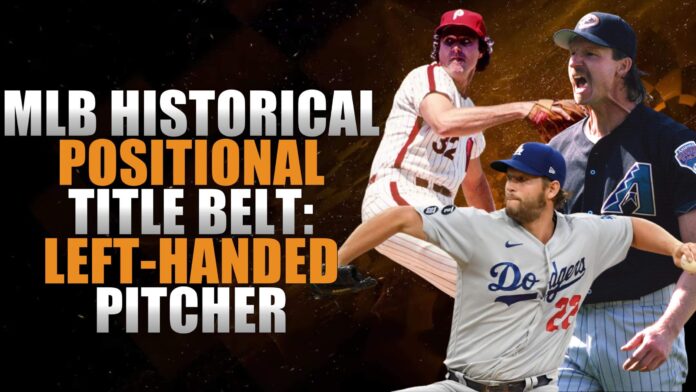Have you ever wondered who the best baseball player alive was in any given year? No? Well, I have. Check out the first article in this series for an explanation of the rules. Next up, left-handed pitching. Specifically, starters, though relievers rarely accumulate enough value to matter. To the list!
Pre-Deadball 1871-1900
At the beginning of time or around 1871, baseball, more or less as we know it, became a professional sport. The first 29 years are known as “Pre-Deadball” because they preceded the next era, “Deadball” and came before the first World Series. It’s like Baseball’s B.C. Left-handed pitching has always been a premium and it was several years before a lefty distinguished himself enough to qualify for the belt (from a metric standpoint, I’m requiring that the pitcher reach at least a wcWAR+ of 30.0 to qualify).
Toad Ramsey 1885-
For years lefties came and went, some pitchers even pitched with both hands, and no one had the staying power to accumulate enough value to hold the belt. Finally, in 1885, Thomas “Toad” Ramsey debuted for the Louisville Colonels. He pitched for 6 years and was particularly impressive his 2nd year, in 1886, when he had a 2.45 ERA in 588.2 IP and completed 66 of his 67 starts. He won 38 and 37 games consecutively in ‘86-87 but then lost 3 seasons to injury. He returned for a final year in ‘90 and led the Colonels to the American Association pennant.
Ted Breitenstein 1891-
Ramsey retired and Theodore J. Breitenstein debuted the very next season. Left-handed pitching was behind the curve and most of Breitenstein’s value is purely persistence, while his career 4.04 ERA is slightly better than average for his era, he was only really great one year, in 1893, when he won the ERA title with a 3.18 over 382.2 IP. Still, his 84.1 wcWAR+ was good enough to keep the belt until 1897.
Rube Waddell 1897-
The first great lefty in league history was George “Rube” Waddell. Rube led the league in K’s for six-straight seasons, won the ‘05 triple crown and a pair of ERA titles. He piled up 46 Black Ink points and finished his career with a 2.16 ERA over 2961.1 IP. His career expanded into the Deadball era but he was overshadowed after holding the belt into the new century.
Deadball 1901-1919
The Deadball era was known for speed, bat-to-ball skills, terrible fields, horrible defense, and dominant pitching. More lefties that met the minimum qualifications for a belt debuted between 1900 and 1912 than in the previous thirty years. Two names stood above them all; first, there was Eddie.
Eddie Plank 1901-
Edward Stewart Plank was one of the greatest lefties of all time. He pitched for 17 years piling up 2246 K’s over 4495.2 IP, a 326-194 record, and an ERA+ of 122. Because of the next name on the list, Eddie doesn’t have a lot of Black Ink but his Gray Ink (top 10 in a category) is 18th all-time for pitchers. He logged 410 complete games and 69 shutouts, 5th all-time and 2nd among lefties. He held the belt till he retired nearing the close of the Deadball era.
Liveball 1920-1941
Ruth symbolized the transition from Deadball to Liveball as he began hitting baseballs over fences in great numbers. The twenty-one years that followed saw the sport grow in popularity before reaching a critical point in American history and pushing into the next era, Integration. Plank retired, and an in-betweener bridged the era to the next great lefty.
Eppa Rixey 1918-
Eppa Rixey debuted back in 1912 and was one of the 27 HOFers to serve in World War I. Rixey, Herb Pennock, Wilbur Cooper, and Earl Whitehill were the standout lefties who pitched between Plank and the next name on the list. Rixey’s 118.0 wcWAR+ outpaced the rest due to his steady excellence evidenced by his 9-straight seasons of above-average ERA+ peaking at 142 in 1925. He finished with a 3.15 ERA over 4494.2 IP with 1350 K’s and 37 shutouts.
Lefty Grove 1928-
Robert Moses Grove was so good with his left hand, everybody knows him as Lefty. During the era of offensive explosion, Grove stood out as a particularly stingy hurler. He led the league in ERA a whopping 9x and finished with an eye-popping 148 ERA+. He’s 3rd all-time in Black Ink for pitchers and secured the ‘31 MVP with a 31-4 record, a 2.06 ERA, 27 complete games, and an insane 217 ERA+. He maintained excellence all the way through the 1930s and subsumed other lefty’s excellent careers such as Carl Hubbell and Larry French. His 209.2 wcWAR+ is 2nd among lefties behind a later belt holder. Just ahead of the league’s Integration era star.
Integration 1942-1960
Jackie Robinson, Larry Doby, Roy Campanella, Hank Aaron, Willie Mays, Satchel Paige and so many more burst into the major leagues as the color barrier fell. Their brilliance and impact were immense in their own right and furthered the disappointment that so many greats toiled in obscurity behind the veil, such as Josh Gibson, Bullet Rogan, and Oscar Charleston.
Warren Spahn 1942-
Warren Spahn debuted quietly and then went off to war and served in WWII. When he returned, he put in 20 straight seasons of steady excellence culminating in a 3.09 ERA over 5243.2 IP, 2583 K’s (9th among lefties), 363 wins (6th all-time), and a 101 Black Ink score. His 63 shutouts are 6th all-time and 3rd among lefties. Other dominant lefties, such as Whitey Ford, Billy Pierce, Hal Newhouser, and even Sandy Koufax never rose up and took away Spahn’s crown. Similar to the smooth transition from Grove to Spahn, the next star debuted the year his predecessor retired and symbolizes the Expansion era.
Expansion 1961-1976
In 1961, the Los Angeles Angels and Washington Senators (Texas Rangers) joined the league. Then in ‘62 the New York Mets and Colt .45’s (Houston Astros) joined. Again in 1969 four more teams were added, the Kansas City Royals, Montreal Expos, San Diego Padres, and Seattle Pilots (Milwaukee Brewers). There have been three other expansion years but the sudden influx of major league roster spots in the 60s and 70s had competing effects of diluting the talent pool and giving more players opportunities to shine. A single lefty dominated the era and for the 3rd straight case, didn’t relinquish it until retiring.
Steve Carlton 1966-
4x Cy Young winner Steve Norman Carlton was as dominant as Spahn and Plank before him putting up a massive 205.0 wcWAR+. In his best season, ‘72, he secured the Cy with 301 K’s, and a 1.97 ERA over 346.1 IP. His 27 wins that season were 46% of the last-place Phillie’s total. Carlton is one of four pitchers to strike out over 4000 men and only one of two lefties to reach that mark. He and the next starter overlapped the entire Free Agency era, remaining on the throne over other significant lefties such as Tommy John, Frank Tanana, Jim Kaat, and Chuck Finley.
Free Agency 1977-1993
As the Mariners and Blue Jays were added signaling the end of the expansion era in ‘77, the reserve clause fell in ‘75, and a new Basic Agreement went into effect in ‘76, Players were now free to move around the league. It was a right-handed pitching great who first took advantage, in 1974 Catfish Hunter left the Athletics and signed with New York. Carlton pitched all the way to ‘88 before the debut of the Big Unit who is really a star of the next era.
Wild Card 1994-2011
After the disaster, which I blame on Bud Selig personally, of the ‘94 stoppage, the players and owners agreed to add more playoff teams, restructure the league, and it took the shape of the “modern” game. This era could also be called the Steroid Era but I went with Wild Card. Its ace was the 2nd greatest lefty ever by wcWAR+ and who some believe is the greatest pitcher ever.
Randy Johnson 1988-
With long flowing locks, angular elbows, a combination of angry eyebrows and mustache, and one of the filthiest sliders known to man, Randy Johnson was a beast. The 5x Cy Young winner took home four in a row from age 35-38 as he led the Arizona Diamondbacks through their peak and to the ‘01 title. His 4875 K’s are 2nd all-time behind Ryan. He collected 4 ERA titles, a 99 Black Ink score, and in ‘01 put up a 10.4 fWAR season. That year he had a 2.49 ERA and 372 K’s over 249.2 IP for a 13.41 K/9. The theme continued as he pitched into his mid-forties and then handed the crown over to the next phenom.
Expanded Playoffs 2012-Now
Coming up with a name for the current era was difficult. It hasn’t quite been long enough to truly evaluate the years since they added another playoff team. Rules have changed, teams have changed names and divisions, and the game has rapidly transformed into an extremely efficient display of athleticism and power. Yet another dominant lefty has stood head and shoulders above his peers since debuting 13 years ago.
Clayton Kershaw 2010-
It appears right now that the already HOF-quality career Clayton Kershaw has is only the beginning. Still delivering a dominant 174 ERA+ this season at age-35, it’s conceivable that he has 5-6 more quality years in his arm. An arm that has led baseball in ERA 5x, won 3 CY Young awards and an MVP, and K’d 2912 batters. He’s the active leader in shutouts, winning percentage, ERA+, and HR per 9. My favorite stat about Kershaw is that from 2009-2017 he lowered his career ERA every year. It’ll be a pleasure to see how much more I would need to mention if I wrote this paragraph after he retired and was assuredly immortalized in Cooperstown.
So there you have it, the left-handed starter title belt holders:
Toad Ramsey 1885-1890
Ted Breitenstein 1891-1897
Eddie Plank 1901-1917
Eppa Rixey 1918-1927
Lefty Grove 1928-1940
Warren Spahn 1942-1965
Steve Carlton 1966-1987
Randy Johnson 1988-2009
Clayton Kershaw 2010-2023







